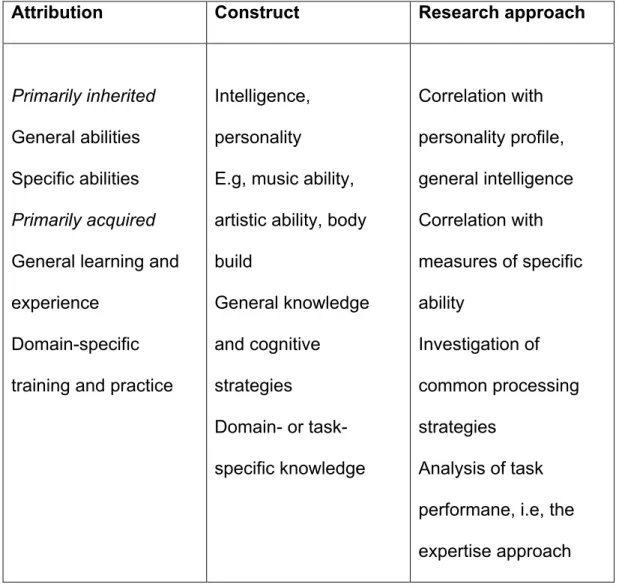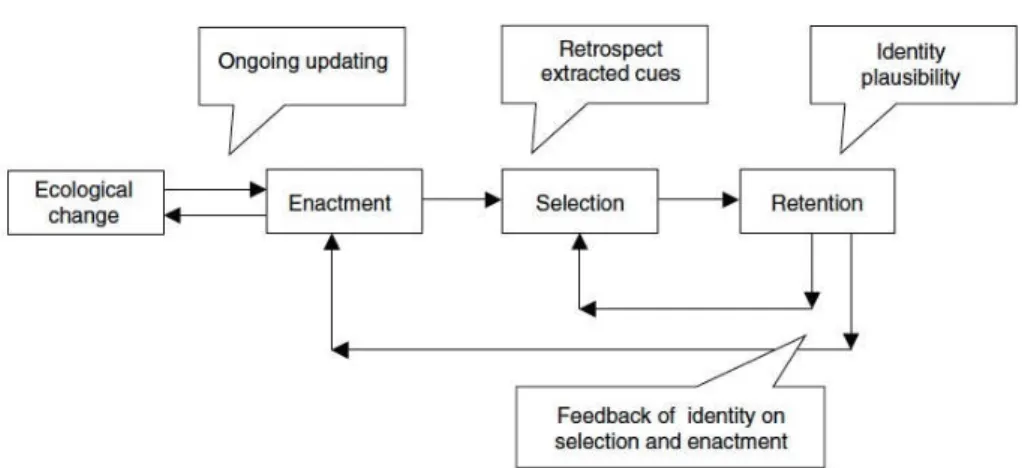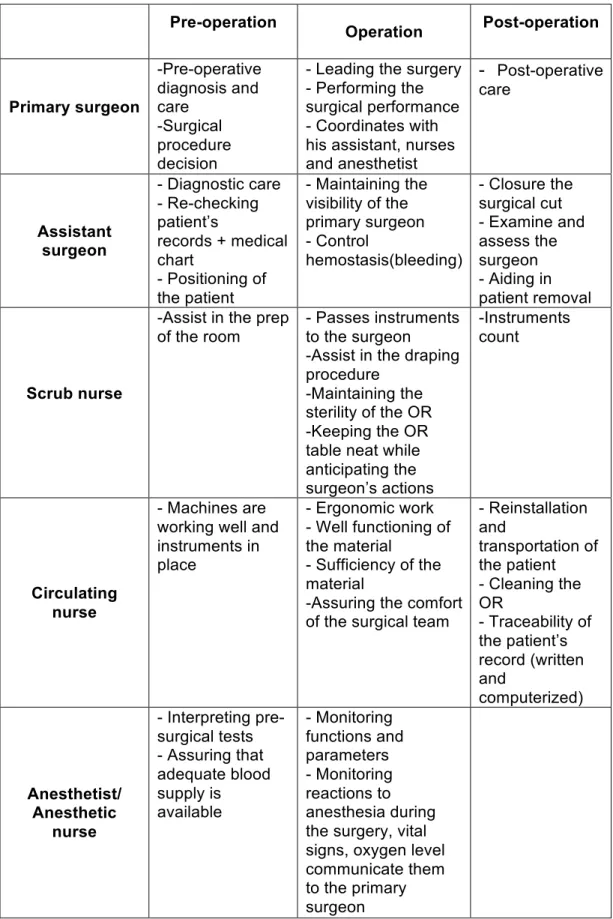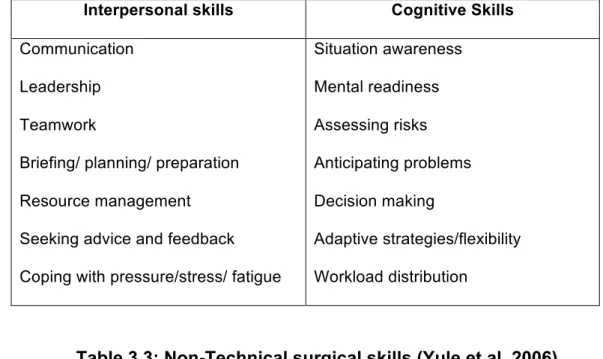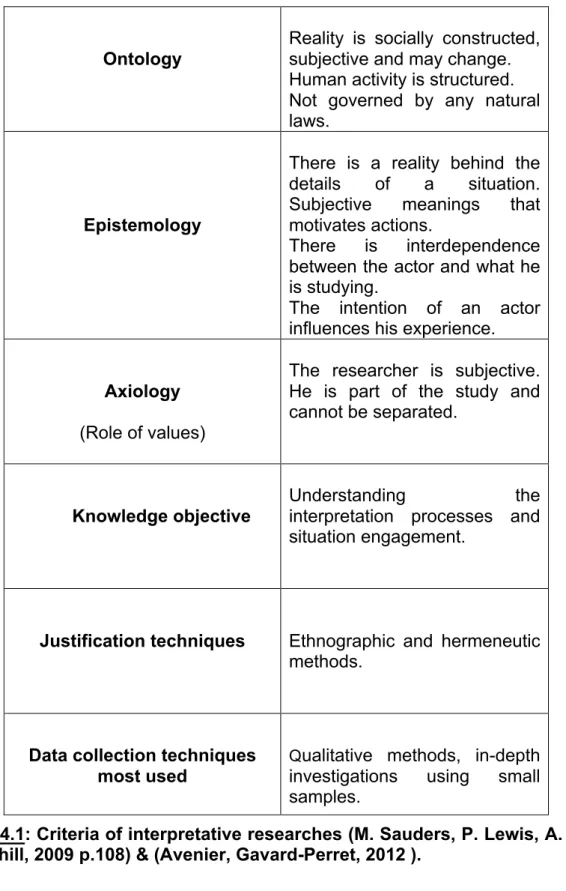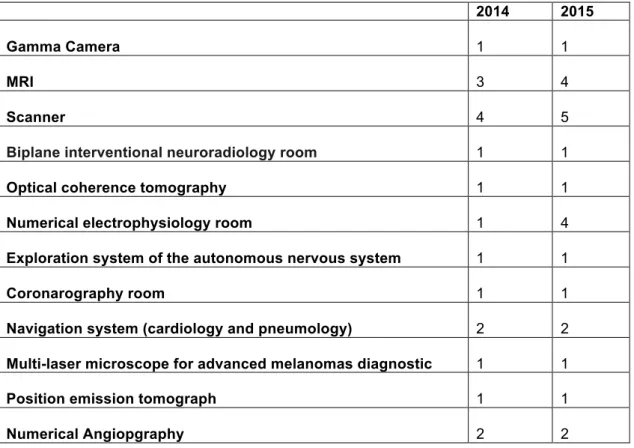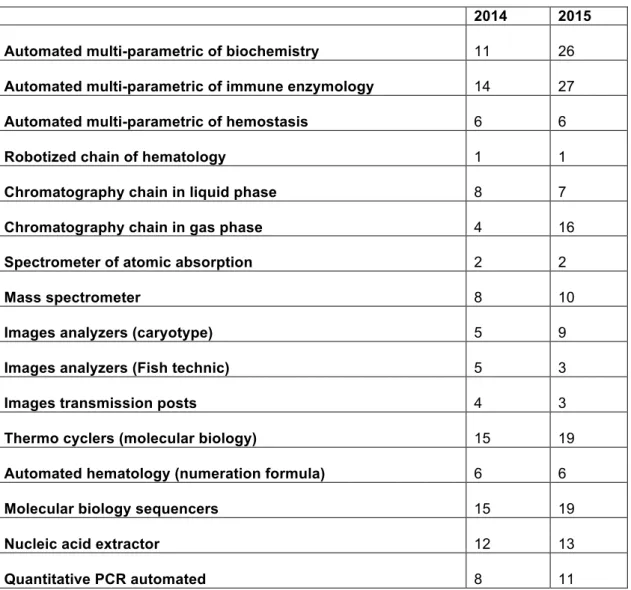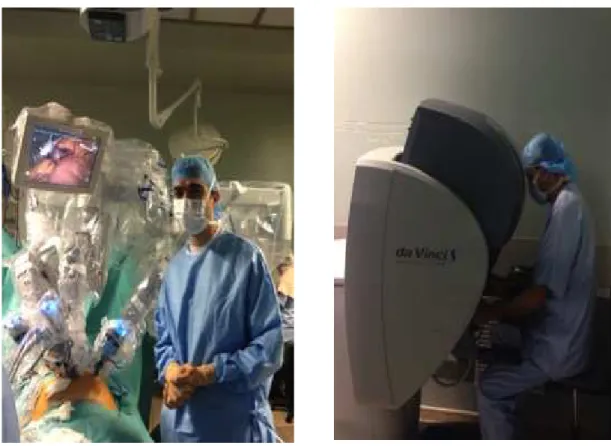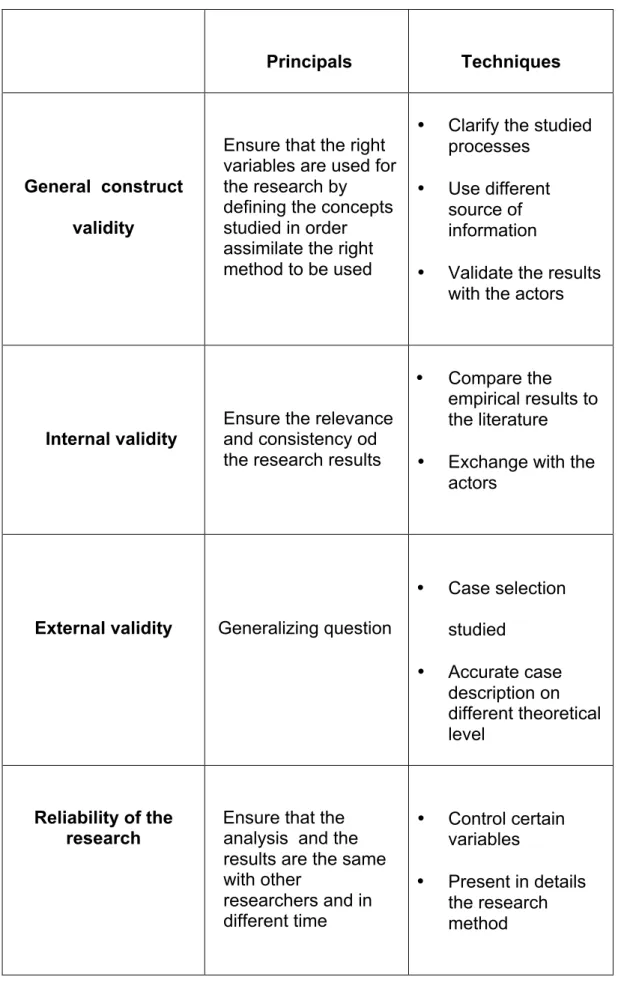HAL Id: tel-01624399
https://tel.archives-ouvertes.fr/tel-01624399
Submitted on 26 Oct 2017
HAL is a multi-disciplinary open access
archive for the deposit and dissemination of sci-entific research documents, whether they are pub-lished or not. The documents may come from teaching and research institutions in France or abroad, or from public or private research centers.
L’archive ouverte pluridisciplinaire HAL, est destinée au dépôt et à la diffusion de documents scientifiques de niveau recherche, publiés ou non, émanant des établissements d’enseignement et de recherche français ou étrangers, des laboratoires publics ou privés.
Effets d’une nouvelle technologie sur l’expertise. Le cas
de la robotique dans la chirurgie bariatrique
Lea Kiwan
To cite this version:
Lea Kiwan. Effets d’une nouvelle technologie sur l’expertise. Le cas de la robotique dans la chirurgie bariatrique. Gestion et management. Université Côte d’Azur, 2017. Français. �NNT : 2017AZUR0018�. �tel-01624399�
I
Acknowledgements
Looking back at my PhD years I want to express my sincere gratitude to the
people who helped me throughout this journey.
To my supervisor Dr. Ivan Pastorelli a big thank you. Thank you for always
being there for me, for offering me help whenever I met difficulties, for your
continuous support, patience and motivation. Thank you for being my
mentor and advisor during my PhD years and orienting me towards better
carrier choices. Dr. pastorelli your passion about aviation gave me a lesson
in life for always following my passion. Our intellectual exchange guided me
throughout my PhD.
Thank you to Nathalie Lazaric. Nathalie, thank you for sharing your
knowledge and expertise in a field that was unknown to me. For believing in
me. Thank you for being there, I had the privilege working with you.
I would like to thank the rest of my thesis committee: Professor Godé and
Professor Saglietto thank you for being part of my jury. Professor Lebraty
and Professor Bidan thank you for accepting being my “rapporteurs”.
Doctor Ben Amor thank you for letting me in your operating room observing
you working with your team. Thank you for explaining to me every step in
the surgical procedures in order to be more familiar with it. Thank you
Doctor Kassir for being part of my jury members.
Thank you for my friend Dr. Tarek Debs for being there and allowing me
integrate the surgical team in CHU Archet 2- Nice.
I want to thank my fellow labmates and all GREDEG members. These past
II Thank you Petra, Savéria, Elise, Joslem, Lisa, Sévérine, Floriant, Martine,
Nabila, Ankinée.
Thank you for the management department “composante gestion” members
Catherine, Cécile, Evelyne, Aura, Lise, Amel, Rani.
Josselin thank you for helping me throughout the beginning of my PhD years
and orienting my work.
A special thank you for my friends Cyrielle, Loubna and Mira. We shared
lots of amazing memories together. Thank you for always being there. I
hope this friendship will last forever. Thank you Laurence for taking care of
us.
Thank you for DEA department in IUT Nice for integrating me the last three
years in your team especially Nicolas Bernard. I had a blast teaching in your
department.
Thank you to my closest friends in France Georges, Lama, Jad and Jinane
who always made me feel like I am home away from home. Thank you for
your presence in my life. Lama, you and what you’ve accomplished are
such a motivation for me. To my friend Anoosheh thank you for the
sleepless nights we were working together before deadlines.
Last and not least, the biggest thank you for my parents and brother. Gaby,
Laudy and Johnny without you I would never accomplish what I
III
THESIS STRUCTURE
GENERAL INTRODUCTION
Part I
Conceptual background of expertise and the relation between technological artefacts implementation and organizational routines
Chapter 1 – Cognitive expertise overview and decision making process 1. The different approaches of expertise
2. The adaptive approach to taking action: the naturalistic approach in particular recognition-prime model
Chapter 2 – Interpersonal expertise: from organizational routine’s perspective
1. Organizational routines stability in changing environnent 2. Technological artefact at the center of routines
Chapter 3 – Healthcare evolution and technology implementation 1. Medical context: diagnosis and treatment
IV
Part II
Towards a comprehension of technology implementation process and its effects
Chapter 4 – Methodological choices and methods of analysis 1. Research interpretative approach
2. Towards critical decision method and ethnography
Chapter 5 – Implementation of a technological artefact in surgery 1. Interviews outcome
2. Robotics in bariatric surgery case study
Chapter 6 – Comprehension of the implementation process 1. Technology implementation and individual expertise 2. Technology implementation and collective expertise
V Table of content
General introduction………....………..…….1
Part I: Conceptual background of expertise and the relation between technological artefacts implementation and organizational routines...……...14
Chapter 1: Congnitive expertise overview and naturalistic decision making process……….………...………...17
Chapter 1 introduction……….………....…....17
1.1 Expertise and experts………...………….18
1.1.1 Definition……….………..…...…18
1.1.2 Experts and errors………...….…21
1.1.3 Operative vs. cognitiveimages………..……….…...…22
1.1.4 Medicine and expertise………..…………...24
1.1.4.1 Overview………..………... ..24
1.1.4.2 Medical diagnosis as a general skill………..……...……...25
1.1.4.3 Medical expertise and amount of knowledge…………...…...26
1.1.4.4 Medical expertise and organizating knowledge………...27
1.2 Naturalistic approach (NDM) and recognition-primed model………...……...29
1.2.1 Naturalistic approach overview………....….…..29
1.2.2 Recognition-primed decision model………...….33
1.2.2.1 Level 1: simple match………...35
1.2.2.2 Level 2: diagnose the situation…...….………...…...37
1.2.2.3 Level 3: evaluate course of action………...…..39
1.2.3 Role of situation awareness in NDM………...………...42
1.2.4 Role of sensemaking in NDM………...47
Chapter 1 summary………...56
Chapter 2: Interpersonal expertise: organizational routines’ stability in changing environments………...………....…..57
Chapter introduction……….………...57
2.1 Organizational routines’ overview………..………....…..….58
2.2 Characteristics of a routine………..……...…58
2.3 Routines in changing environments………..…...61
2.3.1 Artefacts at the center of routines………..……...61
2.3.2 Role of coordination………...62
2.3.3 Time and repetition for building new patterns of actions………..…...64
2.3.4 Learning new routines………...66
2.3.4.1 Creating new psychological safety………...…..67
2.3.4.2 Team leader’s role in creating psychological safety………...69
Chapter summary………...……...72
VI
Chapter 3: Healthcare background and technology implementation………...73
Chapter introduction………..…....……..73
3.1 Medical context………..……....……74
3.2 Treatments: from open surgery to robotic surgery………..………...…75
3.2.1 Mini-invasive surgery evolution………..………...…..75
3.2.2 Robotics………...……..77
3.2.2.1Robotics challenges: operative time………...…….80
3.2.2.2Robotics challenges: communication in the OR………...…….80
3.3 Operating room (OR) interactions………..………...81
3.3.1 OR efficiency………..………..………....…81
3.3.2 Communication in the OR………..…………...…83
3.3.3 Staff arrangements and roles in the OR………..………...84
3.3.3.1 Surgical team………..………...……85
3.3.3.2 Roles dynamics in the OR………..…...…..91
Chapter summary………...………....……..94
Litterature Gab/Summary of pat I………..……...………....95
Part II: Towards a comprehension of technology implementation process and its effects…………...………...….……...97
Part II Overview ………..………....…………....99
Chapter 4 Methodological choices and methods of analysis………...…....….100
Chapter introduction………....…….….…100 Research planning………...….……....101 4.1 Research philosophy………...………..……102 4.1.1 Onthodology………....……..…….104 4.1.2 Epistemology………....……..………104 4.2 Research design………...…..………108 4.3 Methodology………...…...….….111
4.3.1 Critical decision method………...…..…….111
4.3.2 Ethnography………...…….113
4.4 Case selection………...…114
4.4.1 Field description………...………….114
4.4.2 Case description………...………121
4.4.2.1 Laparoscopy gastric bypass surgery………...…..121
4.4.2.2 Da Vinci Robot………...…..……122
4.5 Data collection………....……...124
VII
4.5.2 Observations………...125
4.5.3 Debriefing………..………...………...126
4.6 Data analysis………...…....…….130
4.7 Reliability and validity of the research………..…...……132
Chapter summary………....…...…136
Chapter 5: Implementation of a new artefact in surgery: robotic system in bariatric surgery………...…...137
Chapter introduction………...………....………..…….137
5.1 Interviews briefing...………...………....……..……...138
5.2 Case of robotic surgery………...……...140
5.2.1 Surgery general description………...141
5.2.2 Robotic surgery case description………...…...143
5.2.3 A comparative case of conventional mini-invasive surgery...146
5.2.4 Comparison with other surgical team………...147
5.3 Themes/codes emerged from our study………...151
Chapter summary………...…...183
Chapter 6: Comprehension of the implementation process…...184
Chapter introduction...184
6.1 Technology implementation and individual expertise...185
6.2 Technology implementation and collective expertise...192
Chapter summary...196
General Conclusion...197
References...207
VIII List of figures:
Figure 1.1: Level 1 RPD model- Simple match………...…..…..36
Figure 1.2: Level 2 RPD model- Diagnose the situation…………..…...……….38
Figure 1.3: Level 1 RPD model- Evaluate course of action…………...………..40
Figure 1.4: Sensemaking and action (Weick et al. 2005)……...……...……..…48
Figure 1.5: Relation between enactment, organizing and sensemaking. Jennings and Greenwood (2003; adapted from weick 1979, p.132)………...55
Figure 2.1: Team leader and technology implementation…………...……..…..70
Figure 2.2: A process model for establishing new technological routines…...71
Figure 3.1: Medical chain & technologies …………..….………...………74
Figure 3.2: Mini-invasive surgery evolution timeline………...………..76
Figure 3.3: Taylor and Stoainovici surgical classification………….……...……78
Figure 3.4: Wolf and Shoham classification with systems examples……...….79
Figure 3.6: Sociotechnical view influences on surgical team performance and surgical outcome (Leach et al 2011) ……...………...…….... 93
Figure 4.1: Research planning………...………101
Figure 4.2: the research ‘Onion` (Saunders et al., 2009, p108)………...……104
Figure 4.3: Interpretative approach (Gavard-perret, Gotteland, Haon &Jollibert 2012)……….………...….106
Figure 4.4: Methodologies methods………...…....…...109
Figure 4.5: Units of th hospital……….….…...…………..120
Figure 4.6: Robotic surgery……….………...………....123
Figure 4.7: Laparoscopic surgery……….……...…………..…123
Figure 5.1: Factors affecting individual decisions in the OR according to the surgeons………...…………..139
Figure 5.2: Laparoscopic bariatric surgery OR configuration……...……..…153
IX
Figure 5.4: Da Vinci robot installation (2)………...…..………. 154
Figure 5.5: Surgeon’s location on the console………..…...……….156
Figure 5.6: Team spatial alignment robotic surgery………..…...…..156
Figure 5.7: Actors alignment and interactions in the OR in laparoscopic surgery………..……....……..171
Figure 5.8: Actors alignment and interactions in the OR in robotic surgery………...………...…..172
Figure 5.9: Temporary routinization factors in bariatric robotic surgery…...181
Figure 6.1: RPD and robotic implementation ………...…….191
Figure 6.2: Summary of provisional pattern of action in bariatric robotic surgery………...……….195
Figure –I-: First theoretical contribution………...…….198
Figure –II-: Second theoretical contribution………...……..199
Figure –III-: Third theoretical contribution………...………...201
Figure –IV-: Methodological contributions………...……….…202
Figure –V-: First managerial contribution………...………..203
Figure –VI-: Second managerial contribution………...…………..….204
X List of tables:
Table 1.1: Ericson K. and Smith J. (1991), Towards general theory of expertise:
prospects and limits……….….21
Table 3.1: Principles of scientific management theory applied to OR (M. McLaghlin 2012)………..…..………82
Table 3.2: Surgical team individual roles……….………..90
Table 3.3: Non technical surgical skills (Yule et al. 2006)…….…………..………..92
Table 4.1: Criteria of interpretative researches (M. Sauders , P.Lewis, A.Thornhill, 2009 p 108 ) & (Avenier , Gavard-Perret, 2012)………...107
Table 4.2: Technical platform of medical imagery and functional exploration…...117
Table 4.3: Technical platform of surgical techniques………..…….117
Table 4.4: Technical platform of medical biology………118
Table 4.5: Reliability and validity test according to Yin (1994)………….……….133
Table 4.6: Criteria of evaluating interpretative research Klein and Myers (1999)...134
Table 5.1: Factors affecting communication……….…167
Table 5.3: First order analysis (1)...173
Table 5.4: First order analysis (2)...174
Table 5.5: First order analysis (3)...175
Table 5.6: First order analysis (4)...176
Table 5.7: First order analysis (5)...177
Table 5.8: First order analysis (6)...178
Table 5.9: Second order analysis (1)...179
Table 5.10: Second order analysis (2)...180
General introduction
2 and coordination patterns. Adoption of a new technology has a direct
effect on an expert’s behavior. Lots of studies had already demonstrated
the changing behaviors of experts while implementing a new technology.
To begin with, we define an “expert” as an individual having a high amount
of knowledge in a certain domain. Therefore, expertise is the degree of
knowledge and abilities in a specific field, based on the intensity and
quality of past experiences (Salas, 2010). It consists of having a high level
of performance using deformed subjective operative images (Pastorelli,
2009). Naturalistic scholars studied the expert’s decision-making process
while facing a critical situation (Klein, 2001). Naturalistic research
illustrated how experienced individuals working in highly dynamic and
uncertain environments take decisions. The term “naturalistic decision
making” appeared in 1989. Studies using this approach focus on decisions
taken by experts in their real-life work settings instead of laboratory
settings (Lebraty, Pastorelli-Nègre, 2004). Based on different action
research, an analysis model on the intuitive decision was elaborated and
called “Recognition-Primed Decision” model (RDP) (Lebraty, 2007, p.34).
This approach describes how experts take decisions while taking into
consideration operational parameters. RPD has three possible paths of
decisions making routines, depending on each situation encountered.
According to the naturalistics, there is an assessment to solve a particular
problem. There is a gap in the naturalistic literature on how a technological
artefact, that changes an expert’s role, affect his decision recognition’s
General introduction
3 On the other hand, in addition to the new technical medical skills required
and the personal cognitive skills stated above i.e decision making, medical
expertise includes interpersonal skills. Interpersonal skills are the skills
that allow the surgeon interact with the other surgical team members in the
OR. These interaction patterns in the OR are routinized. When dealing
with change, these patterns are affected. Therefore, when we discuss
about technology adoption in an organization, we also take into
consideration the impact on new interaction patterns among individuals
which will therefore be disrupting their old routines. The concept of
routines is at the center of organization evolution facing changes i.e.
technological evolution. A routine is defined as “repetitive recognizable
patterns of interdependent actions, carried out by multiple actors”
(Feldman and Pentland, 2003:93). In this direction, scholars underlined
the importance of actions (social) and artefact (material) that produces a
routine where expertise and knowledge are required (Jarzabkowski et al.,
2016: 118). Artefacts are mediators of human cognition and activity, and
are the interface between ostensive visions of routines and their
performance. Material artefacts are involved in the individual and collective
pattern of action.
Having this background in mind, our main interest is to illustrate the effect
of a technological artefact on the individual decision making process of an
expert and on the collective team work when dealing with new ecologies of
space thus creating new interaction patterns. In order to do so, our case
General introduction
4 Healthcare is a promising field for observing changing pattern of action
with the implementation of a new technological artefact (Edmondson et al.,
2001, 2004; Bucher and Langley 2016; Compagni et al., 2015; Pisano et
al., 2001 and others). This sector is encountering continuous
development since three decades. Surgery presents one aspect of
healthcare evolution. It was marked by three main events: the shift from
conventional open surgery to mini-invasive surgery (laparoscopy) and from
this this latter to robotic surgery. In the 1980’s there was a big evolution in
surgical procedures with the introduction of mini-invasive surgery (MIS).
Starting 1990’s MIS started expanding and open surgery started to
disappear. MIS consists of making small incisions through which the
surgeon can operates using laparoscopic instruments and cameras. This
technique is called laparoscopy. The main objectives of laparoscopy were
to reduce patient’s pain and post operation recovery time mainly due to
the trauma caused by large incisions (G. Gruthart, J. Salisburg, 2000). The
limited freedom of movement of the surgeon’s hand instruments
manipulation and the limited 2D images provided were considered
technical challenges that surgeons face. In order to overcome these
difficulties, scientists started looking for a way to evolve MIS and the
difficulties encoutered by laparoscopy. As a consequence, robotic surgery
was developed. Robotic surgery is a type of MIS that was expanding fast
in the last decade since its introduction. The da Vinci robot is one of these
robotic surgical systems developed to improve conventional laparoscopic
procedure. The system was FDA (food and drug administration) approved
General introduction
5 the world. There was a remarkable increase in the Da Vinci robot’s
adoption by hospitals. Da Vinci robot consists of the robotic arms and the
console. During robotic surgery, the instruments held by the robotic arms
are inserted into the patient and manipulated by the surgeon who is sitting
at the console located in the operating room outside the sterile field. The
system is design in a way to replicate the surgeon’s movements.
Nowadays, da Vinci robot is the only available system for soft tissue
(Abrishami et al.2014). Edmondson (2001) illustrated changing routines in
OR while passing from conventional open surgery to MIS. Our study is in
continuity of these studies.
Since its introduction, the robotic system faced controversial debates on
the necessity of its adoption. The MIS and medical literature scholars
studied the feasibility of robotic systems in different types of surgeries from
the technical and medical perspective. One example is a comparison
study on MIS approach and robotics in rectal resection for cancer (I.
Popescu et al 2010). Furthermore, the majority of the medical studies
focused on the performance of the console surgeon from the technical
point of view. Others took into consideration the important role of the
patient-side surgeon in this type of surgery (O. Sgarbura, C. Vasilescu
2009). However, it was not until recently that scholars from other
disciplines started being interested in robotic surgery. Few studies
targeted the effect of robotic surgery from the organizational perspective.
A recent study in cognitive science illustrated the impact of robotic surgery
on teamwork specifically on communication and decision making in the
General introduction
6 interested in robotic surgery. Ravasi (2015) studied the social positioning
and skill reproduction in the diffusion of robotic surgery in hospitals. He
answered broader questions on how early implementation influence late
adoptions of technology. Management and organizational literature were
particularly interested in studying the effect of a technological artefact
adoption on expertise and on organizational routines.
In order to do so, we collected ethnographical data after interviewing
experts i.e. surgeons operating with a technological artefact illustrating
how it affects expert’s course of action. Furthermore, it demonstrated how
the current interaction patterns help notably sharing and transferring
expertise. Thus, we were able to document diverse dimensions of learning
a new “ecology of space” (Bucher and Langley 2016), new individual
patterns of action and new interactions among team members. To be more
specific we focused on how experts take decisions with a new team
alignment, how the team creates provisional pattern of action and a new
ecology of space to support the technological artefact implementation. We
answer the following questions: what are the implications of this artefact
on expert’s decision making process when facing a problem? What are the
implications of these artefacts in terms of professional roles,
communication and new forms of coordination? And why some emergent
patterns may stay at an exploratory stage and others may be more
inclined to be performed effectively within an organization?
In brief, our interest is to find the impact of this robotic surgery from both
individual and collective point of view. To be more precise, we aim to
General introduction
7 surgeon) and his decision-making process from the non-technical
perspective. In addition to that, our main interest is to understand how the
Da Vinci robot will change coordination in the OR therefore its impact on
surgical team routines.
In order to answer the questions stated above, we conducted a qualitative
study with an interpretative approach. Before our ethnographic
observation, we started our study with twenty semi-structured interviews
with surgeons from different specialties. The interviews started three years
ago, December 2013. The length of each interview was for two hours. The
aim of this approach was to generate insights from practitioners about their
interaction with the robotic system and with other team members. We
followed the naturalistic approach precisely the critical decision method to
construct the context of our questionnaire. The aim of this approach is to
generate insights from practitioners about their expertise, their decision
making process while facing a critical situation and their interaction with a
new technology like robotic surgery (Hoffman, Klein 2001). The results of
our questionnaires were useful later on in our observation process: we
observed the themes that emerged from our questionnaires.
The heart of our research is an ethnographical study that we conducted in
Nice Hospital, France. Our empirical setting is an operating room routine
in Nice Hospital. We observed 60 hours of gastric bypass surgery
performed with the Robotic system (including 30 hours conducted partially
with the robotic system) and compared them with 15 hours of laparoscopic
gastric bypass surgeries during 3 years starting May 2013. The hospital is
General introduction
8 Surgery evolution is one of the points of interest of the hospital. Robotic
surgery was introduced in the hospital 5 years ago. The robotic system is
used mainly in a regular basis in the hospital in urology whereas it is used
occasionally on Wednesdays in the digestive pole to operate with it during
gastric bypass surgery.
The surgeries observed were video-recorded for further analysis. In
addition to the field observation analysis, we transcripted and conducted
gestures and conversation analysis of the videos recorded. The aim of our
observation study was to understand how a new technology will affect
collective interactions in the OR. Moreover, we concluded our study with a
debriefing with the surgical team with the presence of a psychologist to
understand further the coordination process and new communication
patterns in the OR. We conducted the debriefing after a surgical
procedure. It lasted for an hour and half with the presence of all team
members. All practitioners were exposed to the video of the surgical
procedure recorded thus having an opportunity to understand with
practitioners the nature and the difficulty they may encounter during the
enactment of new interaction patterns.
This led us to an interpretative approach from the epistemological
perspective.
Our empirical findings illustrated the importance of repetition in new
technology adoption. Repetition creates pattern of action recognizable by
the expert, the primary surgeon in our case, when encountering a critical
situation therefore adapting to the situation becomes easier. In our study,
General introduction
9 he is still away from the actual surgical act by being on the console outside
the sterile zone. The new alignment decreased the individual situation
awareness of the surgeon. In order to overcome this issue, he needs flow
of information that will increase his ontological security that was affected.
Thus, collective situation awareness is needed to replace the lack of
individual situation awareness. In our study, technology is brought at the
center of routines (D’Adderio 2011) and the robotic system was adopted in
non-disruptive matter once a week. In this context, novel patterns of action
suffer from a lack of recurrence and new forms of communication appear
to be not really well performed. In the hospital’s context with a clear
division of labor, the team leader’s actions are critical for maintaining the
team stability and psychological safety enabling the adoption of
technological artefacts (Edmondson et al, 2001). In our study, during
robotic surgery, the primary surgeon is the leading actor in the OR. With
the introduction of the robotic system, actions are centralized around him
due to new role repartition, modes of communication and human’s
interactions. This led to a more centralized form of coordination and a new
ecology of space reinforcing his position and his responsibility in case of
misfit. Moreover, being away from the patient with this new ecology of
space, creates a new form of interaction that remain unfamiliar to the
teams ‘s leader and his or her team. Thus the team’s leader (here the
primary surgeon) can not transfer his own expertise to the rest of the team
creating a situation where exploration is observed but not performed
efficiently. Leaning by trial and error is in fact a normal situation
General introduction
10 the professional context observed in hospitals faces with many difficulties
impeding to give resources, time for learning and enabling conditions for
new patterns of action to be performed smoothly. As a result, a new sort of
provisional coordination is maintained without creating possibility for
potential routinization. Thus, new forms of procedural knowledge for
implementing reliable interactions enabling emergent patterns of actions to
be performed smoothly are lacking and patterns remain provisional ones
(Lazaric and Denis 2005). Finally, another methodological question
emerges from our ethnographic study: the place of researcher who is
using video- recording. For instance, we may ask to what extent our
observations is interfering (or not) on reality and on patterns of action that
can be different with the absence of this recording. This issue was well
debated by psychologists from the ethics point of view (Leroy et al., 2012,
Bobiler-Chamon and Clark 2008). Psychologist scholars tried to use
debriefing (Hamed et al., 2007) with the observed team as a method to
avoid any ambiguity and have assurance about the data. In our study we
explored a debriefing with the surgical team in order to understand further
some of the actor’s human and technology interactions. This issue was not
really embraced by organizational scholars and deserves greater attention
in ethnography for future research in this field.
From theoretical perspective, our qualitative study enabled us to enrich the
naturalistic theoretical approach on expert’s decision making processes
when the role of this latter as a team leader is affected. It enabled us also
to understand the the difference between individual expertise and new
General introduction
11 a technological artefact creates provisional routines when new ecologies
of space are encountered. From the managerial perspective, we were able
to give recommendations for organizations that are dealing with the same
technological adoption situation. We illustrated the impact that has a new
technological artefact adopted on individual and team work hence
affecting the whole organization. The OR is a sample representation of a
managerial system where a manager is leading his team. We
demonstrated that a technology can have a negative influence on the
coordination aspects of the team. We are going through an era of
digitalization. Even though robotic surgery is not automated and assisted,
it gives us a small overview of how healthcare system is going through
evolution that will totally remodel the healthcare system especially
treatment chain.
This thesis is composed of two parts. First part is dedicated for the
theoretical concepts. It has three chapters each one specific to a literature
overview. Chapter one presents a summary of the literature on the
naturalistic approach , research studies on expertise and decision
processes. Chapter two presents a theoretical perspective on
organizational routines and changing routines while dealing with a new
artefact. It introduces the notions of time and repetition to explain the
formation of a new ‘ecology of space’. Last chapter in this part consists of
an overview of the medical context with a brief presentation of scholar’s
work in this area on new technologies, specifically robotic surgery.
In part two, the research methodology applied in this study and the
General introduction
12 underlying research philosophy in terms of ontology, epistemology and
methodology. This is followed by a presentation of how the model used is
executed and methods of analysis afterwards. It presents the context in
which we gathered our empirical data and conducted the ethnographical
observation.
Chapter 5 illustrates details on the empirical findings of our research. It
provided first the data collected, analyzed with the findings.
Chapter 6 is our discussion chapter. Our research findings were discussed
through cross-validation with the literature, interpreting the possible
reasons for the results and the implication of this later.
Our general conclusion reviews our research process and research
findings. The research question is answered clearly. Moreover, the
theoretical and managerial implications are presented. We end our
conclusion with the strengths and limitations of our study and
General introduction
13
Summary / Résumé (Français)
Cette thèse s’intéresse aux effets des technologies d’assistance robotique
sur l’expertise individuelle et collective des médecins dans un bloc
opératoire de chirurgie gastrique. Notre recherche est fondée sur l’analyse
de l’émergence des routines organisationnelles et de leur mise en
évidence en mobilisant l’approche naturaliste de la décision
L’adoption d’une nouvelle technologie présente un exemple d’incertitude
qui exigent une coordination plus renforcée entre les membres d’une
équipe « effective teaming » (Edmondson, 2001 ; Edmondson and Zuzul,
2016). La mise en œuvre d’une nouvelle technologie perturbe les rôles
respectifs de chaque membre de l’équipe (Black et al, 2004). Par
conséquent, la création de nouveaux modèles d’interaction est
nécessaire. L’impact est à la fois cognitif (expertise individuelle) et collectif
(interaction et coordination). D’autre part, l’adoption d’une nouvelle
technologie a un effet direct sur le comportement d’un expert. Plusieurs
études ont déjà démontré l’évolution des comportements des acteurs lors
de l’adoption d’une nouvelle technologie. Les recherches naturalistes ont
illustré comment les individus expérimentés qui travaillent dans des
environnements très dynamiques et incertains prennent des décisions. Le
terme “prise de décision naturaliste” est apparu en 1989. Les recherches
utilisant cette approche se concentre sur les décisions prise par des
experts dans leur milieu de travail et non pas lors des simulations dans
des laboratoires (Lebraty, Pastorelli-Nègre, 2004). En se basant sur
General introduction
14 et appelé “Recognized-primed decision model” (RDP) (Lebraty, 2007,
p.34). Cette approche décrit comment un expert prend des décisions en
tenant compte des paramètres opérationnels. La RPD comporte trois cas
possibles de prise de décision en fonction de la familiarité de chaque
situation. Selon les naturalistes, il existe une évaluation pour résoudre un
problème particulier. Dans cette littérature, nous trouvons un manque
d’information sur la façon dont un artefact technologique impact le modèle
de reconnaissance d’une situation.
Par ailleurs, de plus des compétences techniques médicales requises et
des compétences cognitives personnelles énoncées, l’expertise médicale
inclut aussi les compétences interpersonnelles. Ces dernières permettent
au chirurgien d’interagir avec les autres membres de l’équipe dans le bloc
opératoire. Ces modèles d’interaction sont routinisés au sein du bloc. Face
à un changement, ces interactions sont affectées. Par conséquent,
lorsque nous adoptons une nouvelle technologie dans une organisation
nous prenons en considération l’impact de ces nouveaux modèles
d’interaction entre les membres de l’équipe qui vont donc perturber leurs
anciennes routines. Le concept des routines se positionne au centre de
l’évolution et du changement de l’organisation. Une routine est définie
comme un modèle reconnaissable répétitif d’action interdépendantes,
réalisées par de multiples acteurs (Feldman and Pentland, 2003 :93).
Dans cette direction, les chercheurs ont souligné l'importance des actions
(sociales) et des artefacts (matériels) qui produisent une routine où
l'expertise et les connaissances sont nécessaires (Jarzabkowski et al.,
General introduction
15 l'activité humaines et sont l'interface entre les visions ostensives des
routines et leur performance. Les artefacts matériels s’impliquent dans le
modèle d'action individuel et collectif. Dans ce contexte, notre intérêt
principal est d'illustrer l'effet d'un artefact technologique sur le processus
décisionnel individuel d'un expert et sur le travail collectif lorsqu'il s'agit de
nouvelles écologies de l'espace, créant ainsi de nouveaux modèles
d'interaction. Afin d’atteindre cette objectif, notre étude de cas porte sur
l’adoption de la robotique dans la chirurgie gastrique. Dans notre étude
nous avons recueilli des données ethnographiques après avoir interrogé
des experts, des chirurgiens opérant avec cet artefact technologique. En
outre, nous avons démontré comment les modèles actuels d'interaction
favorisent notamment le partage et le transfert d'expertise. Ainsi, nous
avons pu documenter diverses dimensions de l'apprentissage de la
nouvelle « écologie de l’espace » (Bucher et Langley, 2016), nouveaux
modes d'action individuels et nouvelles interactions entre les membres de
l'équipe. Pour être plus précis, nous nous sommes concentrés sur la façon
dont les experts prennent des décisions avec un nouvel alignement spatial
de l'équipe. De plus, comment l'équipe crée des modèles d'action
provisoire et une nouvelle écologie de l'espace pour soutenir la mise en
œuvre de l'artefact technologique. Nous répondons aux questions
suivantes : quelles sont les implications d’un artefact technologique sur le
processus décisionnel ? Quelles sont les implications de cet artefact sur
les les membres de l’équipe : leurs rôles respectifs, la communication et
General introduction
16 émergents peuvent rester à un stade exploratoire et d'autres peuvent être
plus enclins à être effectivement effectuée au sein d'une organisation ?
Le cœur de notre recherche est une étude ethnographique que nous
avons effectuée à l'Hôpital de Nice. Nous avons mené des observations
de soixante heures de chirurgies robotique suivi par les observations de
chirurgies laparoscopiques. Notre méthodologie consiste en un processus
en quatre étapes : (a) entretiens avec des chirurgiens en utilisant la (b)
observations non participantes au bloc opératoire(c) analyse des
chirurgies vidéo enregistrées (d) débriefings et auto-confrontations avec
les chirurgies vidéo enregistrées.
Nos résultats mènent à des contributions du point de vue managérial,
théorique et méthodologique.
Du point de vue théorique, nous avons trois contributions. Tout d'abord,
l'importance de la sensibilisation de la situation. La situation individuelle
(Endsley 2016), l'évaluation du sens de la situation d'un expert dans le
processus décisionnel, en particulier lors de l'adoption d'une nouvelle
technologie est démontrée dans notre étude. Le manque de conscience
de la situation et l'évaluation de la situation diminuent la confiance des
experts, ce qui affecte leur réintégration. Lorsque le raisonnement est
affecté, l'expert ne sera pas en mesure de prendre des décisions pour
choisir un plan d'action efficace adapté à la situation rencontrée.
L'approche naturaliste est basée sur la recherche de ressources non
limitées afin de permettre aux experts de prendre une décision appropriée.
Dans notre cas, le manque de conscience de la situation a diminué la
General introduction
17 limitée lors de l'utilisation du nouvel artefact technologique.
Deuxièmement, l'importance du rôle du chef d'équipe dans la mise en
oeuvre d'une nouvelle technologie au sein de l'équipe (Edmondson 2001,
2004). Du point de vue naturaliste (Klein 2001), nous attribuons un role
important à l’expert lors du processus décisionnel. L’aspect individuel est
pris en considération et non pas l’aspect collectif.
Nous avons démontré le rôle du chef d’équipe / expert sur le processus
décisionnel en équipe. Lorsque l’expertise individuelle est perturbée par le
nouvel artefact technologique, l’expertise collective sera affectée, de sorte
que la création de nouvelles routines performatives durables devient
difficile. Lorsque le chef de l’équipe est encore en phase d’essai et
d’erreur, il ne peut pas transférer ses connaissances et assurer la sécurité
psychologique au reste de l’équipe. Ce dernier élément est essentiel dans
la mise en oeuvre d’une nouvelle technologie (Edmondson 2004).
Troisièmement, la répétition est essentielle pendant l’implementation des
nouvelles technologies. Dans notre étude, la technologie est au centre des
routines (D'Adderio 2011). Le système robotique a été adopté de manière
non perturbatrice une fois par semaine. Dans ce contexte, de nouveaux
modèles d'action souffrent d'un manque de récidive. Par conséquent, de
nouvelles formes de communication semblent ne pas être vraiment bien
exécutées. Dans le contexte hôspitalier avec une division claire du travail,
les actions du chef d'équipe sont essentielles pour maintenir la stabilité de
l'équipe et la sécurité psychologique permettant l'adoption des artefacts
technologiques (Edmondson et al., 2001).
General introduction
18 qui crée une nouvelle forme d'intéraction reste inconnue par le chef
d'équipe et le reste de l’équipe. Ainsi, le leader de l'équipe (ici le chirurgien
principal) ne peut pas transférer son propre expertise au reste de l'équipe
en créant une situation où l'exploration est observée mais pas vraiment
efficace. L’apprentissage par essais et erreurs est en fait une situation
normale rencontrée par de nombreuses organisations (Rerup et Feldman
2011).
Cependant, le contexte professionnel observé dans les hôpitaux fait face à
de nombreuses difficultés empêchant de donner des ressources, le temps
nécessaire, l'apprentissage et la mise en place harmonieuse des
conditions pour que les nouveaux modes d'action se déroulent.
En conséquence, une nouvelle sorte de coordination provisoire est
maintenue sans créer de possibilité de routinisation potentielle. Ainsi, il
manque de nouvelles formes de connaissances procédurales pour
implémenter des interactions fiables qui permettent de réaliser en douceur
des modes d'action émergents. En conséquence, les modèles restent
provisoires (Lazaric et Denis 2005).
Dans notre étude, lors de la chirurgie robotique, le chirurgien principal est
l'acteur principal dans le bloc opératoire. Avec l'introduction du système
robotique, les actions sont centralisées autour de lui en raison des
nouvelles répartitions des rôles, de modes de communication et
d'interactions humaines. Cela a conduit à une forme de coordination plus
centralisée et à une nouvelle écologie de l'espace renforçant sa position et
sa responsabilité en cas d'inadéquation.
General introduction
19 combinée avec d'autres méthodes est rarement utilisée en sciences de
gestion. L'analyse vidéo détaillée basée sur l'analyse de la conversation et
des gestes est généralement utilisée en psychologie (Hostetter 2011,
Krauss et al 1996). Notre étude est un exemple de l'efficacité de
l'utilisation de cette technique dans notre domaine et ouvre la voie à une
utilisation plus fréquente de la technique, en particulier dans les études
ethnographiques. En outre, une question émerge de notre étude
ethnographique : le rôle du chercheur qui utilise l'enregistrement vidéo.
Par exemple, nos observations interfèrent (ou non) sur la réalité et sur les
modèles d'action qui peuvent être différents avec l'absence de cet
enregistrement. Cette question a été bien débattue par les psychologies
du point de vue de l'éthique (Leroy et al., 2012, Bobiler-Chamon et
Clark,2008).
Deuxièmement, les chercheurs en psychologie ont essayé d'utiliser le
debriefing (Hamed et al., 2007) avec l'équipe observée comme méthode
pour éviter toute ambiguïté et avoir l'assurance des données. Dans notre
étude, nous avons exploré un débriefing auprès de l'équipe chirurgicale
afin de mieux comprendre les acteurs et les interactions technologiques.
Ce problème n'a pas été vraiment étudié par les chercheurs de
l'organisation et méritent une plus grande attention dans l'ethnographie
pour des futures recherches dans ce domaine.
Du point de vue managerial, quand une nouvelle technologie est adoptée
par une organisation, cette adoption devrait être sans retour en arrière.
Par exemple, les chirurgiens une fois qu'ils adoptent le système robotique,
General introduction
20 perturbation dans l'adoption. Les organisations sont en évolution
technologique continue. La médecine est un domaine prometteur. Les
nouvelles technologies sont adoptées dans le diagnostic ainsi que dans
les traitements. Les médecins sont formés depuis leurs premières études.
L'aide de la simulation et d'autres types de technologies qui les aideront à
diagnostiquer ou à traiter un cas spécifique, par exemple les serious
games. Tout le milieu médical évolue vers les nouvelles technologies et
l'ère de la numérisation. Dans notre recherche, nous avons été intéressés
par le traitement plus précisément le système semi-assisté robotique. Ce
système robotique a changé les rôles et les interactions au sein du bloc
opératoire. La configuration du bloque opératoire change complètement.
En raison du manque de répétition, cette nouvelle configuration a affecté
l'expertise du chirurgien en termes de perturbation de son processus
décisionnel. En outre, les actes chirurgicaux sont centralisés et le
chirurgien est isolé du reste de l'équipe. En conséquence, les interactions
habituelles entre les membres de l'équipe en fonction de la
communication, de l'anticipation de la coordination et de la prédiction de
l'action de l'autre ont été perturbées en raison du nouvel arrangement
spatial.
Deuxièmement, pour que ce système robotique soit bien adopté, la
gestion des ressources de l'équipage devrait être développée. Au cours
de notre étude, nous avons eu l'occasion de rencontrer des représentants
de l’entreprise qui développe le système robotique que nous observions.
Ils imposent une liste de recommandations, y compris des formations,
General introduction
21 d'accord avec nous sur les erreurs de communication qui peuvent survenir
lors de la chirurgie robotique. Du point de vue technique, l'entreprise
développe plus de fonctionnalités dans le système robotique. Par
exemple, ils intègrent la réalité augmentée pour avoir des informations et
des données complètes. Un autre exemple est le développement de
sensations de retour tactile. En développant ces deux caractéristiques, la
société essaie de compenser la perte de retour tactile et le manque de
conscience de la situation en raison de la distance entre la console et le
patient. L'objectif est de créer une sécurité psychologique pour le
chirurgien. Pourtant, nous avons constaté qu'il est important de minimiser
la distance entre la console et les bras du robot. Cela va créer plus de
sécurité pour le chirurgien. La société a soutenu que la formation cible la
manipulation technique du système robotique pour tous les membres de
l'équipe. Les formations qui guident les nouveaux modèles de
communication et de coordination manquaient.
Troisièmement, cette étude déclenche les idées pour d'autres études surle terrain. L'un d'eux est le risque, les erreurs et la sécurité
General introduction
22
INTRODUCTION GENERALE (Français)
Le 7 Septembre 2001, la première chirurgie transatlantique a eu lieu.
Elle est connue par « l’opération Lindbergh ». Le médecin qui a opéré
était présent à New York tant dis ce que le patient était à Strasbourg
sous la présence de deux autres chirurgiens.
Cette intervention chirurgicale a marqué l‘histoire de la chirurgie. Elle était
le résultat de longues années de recherche sur la robotique et la chirurgie
assistée par ordinateur.
Plusieurs débats ont eu lieu sur l’efficacité et l’efficience de cette
technique sur le chirurgien, l’équipe chirurgicale et sur l’hôpital. L’équipe
chirurgical au seins du bloc opératoire a dû développer des nouvelles
compétences non seulement technique mais aussi cognitives et
interpersonnels afin de pouvoir s’adapter au nouvel artefact
technologique. Cet exemple montre les défis auxquels les organisations et
les praticiens doivent faire face pour maintenir leur stabilité dans un
environnement incertain (Edmondson 2001). L’adoption d’une nouvelle
technologie présente un exemple d’incertitude qui exigent une
coordination plus renforcée entre les membres de l’équipe « effective
teaming » (Edmondson, 2001 ; Edmondson and Zuzul, 2016). La mise en
œuvre d’une nouvelle technologie perturbe les rôles respectifs de chaque
membre de l’équipe (Black et al, 2004). Par conséquent, la création de
nouveaux modèles d’interaction est nécessaire. L’impact est à la fois
cognitif (expertise individuelle) et collectif (interaction et coordination).
General introduction
23 comportement d’un expert. Plusieurs études ont déjà démontré l’évolution
des comportements lors de l’adoption d’une nouvelle technologie. Pour
commencer, nous définissons un “expert” comme un individu ayant des
connaissances dans un domaine précis. Par conséquent, l’expertise est
un degré de connaissances et de capacités dans un domaine spécifique
basé sur l’intensité et la qualité des expériences passées (Salas, 2010).
De plus, ça consiste à avoir un haut niveau de performance en utilisant
des images opérationnelles déformées (Pastorelli, 2009). L’approche
naturaliste a été intéressée par le processus décisionnel de l’expert face à
une situation critique (Klein 2001). Les recherches naturalistes ont illustré
comment les individus expérimentés qui travaillent dans des
environnements très dynamiques et incertains prennent des décisions. Le
terme “prise de décision naturaliste” est apparu en 1989. Les recherches
utilisant cette approche se concentre sur les décisions prise par des
experts dans leur milieu de travail et non pas lors des simulations dans
des laboratoires (Lebraty, Pastorelli-Nègre, 2004). En se basant sur
plusieurs recherches d’action, un model de décision intuitive a été élaboré
et appelé “Recognized-primed decision model” (RDP) (Lebraty, 2007,
p.34). Cette approche décrit comment un expert prend des décisions en
tenant compte des paramètres opérationnels. La RPD comporte trois cas
possibles de prise de décision en fonction de la familiarité de chaque
situation. Selon les naturalistes, il existe une évaluation pour résoudre un
problème particulier. Dans cette littérature, nous trouvons un manque sur
la façon dont un artefact technologique impact le modèle de
General introduction
24 Par ailleurs, en plus des compétences techniques médicales requises et
des compétences cognitives personnelles énoncées, l’expertise médicale
inclut aussi les compétences interpersonnelles. Ces dernières permettent
au chirurgien d’interagir avec les autres membres de l’équipe dans le bloc
opératoire. Ces modèles d’interaction sont routinisés au sein du bloc. Face
à un changement, ces interactions sont affectées. Par conséquent,
lorsque nous adoptons une nouvelle technologie dans une organisation
nous prenons en considération l’impact de ces nouveaux modèles
d’interaction entre les membres de l’équipe qui vont donc perturber leurs
anciennes routines. Le concept des routines se positionne au centre de
l’évolution et du changement de l’organisation. Une routine est définie
comme un modèle reconnaissable répétitif d’action interdépendantes,
réalisées par de multiples acteurs (Feldman and Pentland, 2003 :93).
Dans cette direction, les chercheurs ont souligné l'importance des actions
(sociales) et des artefacts (matériels) qui produisent une routine où
l'expertise et les connaissances sont nécessaires (Jarzabkowski et al.,
2016 : 118). Les artefacts sont des médiateurs de la cognition et de
l'activité humaines et sont l'interface entre les visions ostensives des
routines et leur performance. Les artefacts matériels s’impliquent dans le
modèle d'action individuel et collectif. Dans ce contexte, notre intérêt
principal est d'illustrer l'effet d'un artefact technologique sur le processus
décisionnel individuel d'un expert et sur le travail collectif lorsqu'il s'agit de
nouvelles écologies de l'espace, créant ainsi de nouveaux modèles
d'interaction. Afin d’atteindre cette objectif, notre étude de cas porte sur
General introduction
25 est un domaine prometteur pour l'observation de l'évolution des schémas
d'action lors de la mise en œuvre d'un nouvel artefact technologique
(Edmondson et al., 2001, 2004; Bucher and Langley 2016; Compagni et
al., 2015; Pisano et al., 2001 and others).
Ce secteur est en développement continu depuis trois décennies. La
chirurgie présente un aspect de l'évolution de la chaîne de soins. Elle a
été marquée par trois événements principaux : l’évolution de la chirurgie
ouverte conventionnelle à la chirurgie mini-invasive (laparoscopie) et de ce
dernier à la chirurgie robotique. Dans les années 80, un grand
changement a eu lieu dans les procédures chirurgicales avec l'introduction
de la chirurgie mini-invasive (MIS). À partir de 1990, MIS a commencé à
se développer et par conséquent le concept de la chirurgie ouverte a
commencé à disparaître. Le concept MIS consiste à faire de petites
incisions à travers lesquelles le chirurgien peut opérer en utilisant des
instruments laparoscopiques et des caméras. Cette technique est appelée
laparoscopie. Les principaux objectifs de la laparoscopie consistent à
réduire la douleur du patient et le temps de récupération post-opératoire,
principalement en raison du traumatisme causé par les grandes incisions
(G.Gruthart, J. Salisburg, 2000). Le degré de liberté du mouvement des
instruments par la main du chirurgien est limité. Les images 2D limitées
fournies ont été considérées comme des défis techniques auxquels les
chirurgiens sont confrontés. Afin de surmonter ces difficultés, les
chercheurs ont commencé à chercher un moyen d'évoluer MIS et les
difficultés rencontrées par la laparoscopie. En conséquence, la chirurgie
General introduction
26 s'est développé rapidement dans la dernière décennie depuis son
introduction. Le robot Da Vinci est l'un de ces systèmes robotiques
chirurgicaux développés pour améliorer la laparoscopie conventionnelle.
Le système était FDA (alimentation et administration de drogue) approuvé
en l'an 2000. Depuis, l'utilisation de ce type de systèmes a commencé à
se développer au reste du monde. Il y a eu une augmentation
remarquable de l'adoption du robot Da Vinci par les hôpitaux. Le robot Da
Vinci se compose des bras robotiques et de la console. Dans la chirurgie
robotique, les instruments retenus par les bras robotiques sont insérés
dans le corps du patient et manipulés par le chirurgien. Ce dernier est
assis à la console située dans le bloc opératoire à l'extérieur du champ
stérile. Le système est conçu de manière à reproduire les mouvements du
chirurgien (Abrishami et al.2014). Edmondson (2001), a illustré le
changement des routines au bloc opératoire lors du passage de la
chirurgie ouverte conventionnelle à MIS. Notre étude est en continuité de
ces études.
Depuis son introduction, le système robotique fait face à des débats
controverses sur la nécessité de son adoption. La faisabilité des systèmes
robotiques dans différents types de chirurgies du point de vue technique et
médical a été étudié. Un exemple est celui de l’étude de comparative sur
la chirurgie mini-invasive et la robotique pour une résection rectale du
cancer (I. Popescu et al 2010). Par ailleurs, la majorité des études
médicales ont porté sur la performance du chirurgien de la console du
General introduction
27 du chirurgien assistant dans ce type de chirurgie (O. Sgarbura, C.
Vasilescu 2009).
Cependant, ce n'est que récemment que des spécialistes d'autres
disciplines ont commencé à s'intéresser à la chirurgie robotique. Peu
d'études ont ciblé l'effet de cette chirurgie du point de vue organisationnel.
Une étude récente en sciences cognitives a illustré l'impact de la chirurgie
robotique sur le travail d'équipe spécifiquement sur la communication et la
prise de décision dans le bloc opératoire (R. Randell et al, 2016).
Par ailleurs, les chercheurs en sciences de gestion s'intéressaient à la
chirurgie robotique. Ravasi (2015) a étudié le positionnement social et la
reproduction des compétences dans la diffusion de la chirurgie robotique
dans les hôpitaux. Il a répondu à des questions plus générales sur la
façon dont la mise en œuvre rapide influence les adoptions tardives de la
technologie. Les recherches en gestion et en étude organisationnelle
étaient particulièrement intéressées à étudier l'effet de l'adoption d'un
artefact technologique sur l'expertise et sur les routines organisationnelles.
Dans notre étude nous avons recueilli des données ethnographiques
après avoir interrogé des experts, des chirurgiens opérant avec un
artefact. En outre, nous avons démontré comment les modèles actuels
d'interaction favorisent notamment le partage et le transfert d'expertise.
Ainsi, nous avons pu documenter diverses dimensions de l'apprentissage
de la nouvelle « écologie de l'espace» (Bucher et Langley, 2016),
nouveaux modes d'action individuels et nouvelles interactions entre les
membres de l'équipe. Pour être plus précis, nous nous sommes
General introduction
28 nouvel alignement spatial de l'équipe. De plus, comment l'équipe crée des
modèles d'action provisoire et une nouvelle écologie de l'espace pour
soutenir la mise en œuvre de l'artefact technologique.
Nous répondons aux questions suivantes : quelles sont les implications
d’un artefact technologique sur le processus décisionnel ? Quelles sont
les implications de cet artefact sur les les membres de l’équipe : leurs
rôles respectifs, la communication et les nouvelles formes de coordination
? Et pourquoi certains modèles émergents peuvent rester à un stade
exploratoire et d'autres peuvent être plus enclins à être effectivement
effectuée au sein d'une organisation ?
En résumé, notre intérêt est de trouver l'impact de cette chirurgie
robotique du point de vue individuel et collectif. Plus précisément, nous
cherchons à découvrir comment ce système robotisé affecte l'expert (le
chirurgien principale) et son processus décisionnel du point de vue non
technique. Notre objectif est de comprendre comment le robot Da Vinci va
changer les interactions dans le bloc opératoire donc son impact sur les
routines de l'équipe chirurgicale. Afin de répondre aux questions énoncées
ci-dessus, nous avons effectué une étude qualitative à partir de l'approche
interprétative. Avant notre observation ethnographique, nous avons
effectué une étude avec vingt entrevues semi-structurées avec des
chirurgiens de différentes spécialités. Les entrevues ont eu lieu 3 ans
auparavant, décembre 2013. La durée de chaque entrevue était de 2
heures. Le but de cette approche était de générer des points de vue des
praticiens sur leur interactions avec le système robotique et avec les
General introduction
29 précisément la méthode de décision critique pour construire le contexte de
notre questionnaire. Le but de cette approche est de susciter chez les
praticiens un aperçu de leur expertise, de leur processus décisionnel face
à une situation critique et de leur interaction avec une nouvelle
technologie comme la chirurgie robotisée (Hoffman, Klein, 2001). Les
résultats de nos questionnaires ont été utiles plus tard dans notre
processus d’observation : nous avons concentré notre observation sur les
thèmes issus de nos questionnaires. Le cœur de notre recherche est une
étude ethnographique que nous avons effectuée à l'Hôpital de Nice. Notre
cadre empirique est une routine chirurgicale à l'Hôpital de Nice. Nous
avons observé soixante heures de chirurgie gastrique réalisées avec le
système robotique et nous les avons comparées à quinze heures de
chirurgie gastrique laparoscopique pendant trois ans à partir de mai 2013.
L'hôpital est intéressé par l'adoption de nouvelles technologies pour
maintenir une certaine image compétitive. L'évolution de la chirurgie est
l'un de ces points d'intérêt. La chirurgie robotique a été introduite à
l'hôpital 5 ans auparavant. Le système robotique est utilisé principalement
de façon régulière à l'hôpital en urologie alors qu'il est utilisé
occasionnellement chaque mercredi dans le pôle digestif. Les chirurgies
observées ont été enregistrées pour une analyse plus détaillée. En plus
de l'analyse d'observation sur le terrain, nous transcrivons et menons
analyses gestuelles et de conversation des vidéos enregistrées. Le but de
notre observation était de comprendre comment une nouvelle technologie
va affecter les interactions collectives dans le bloc opératoire. De plus,
